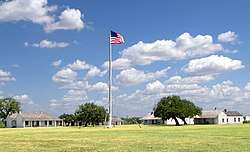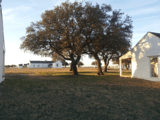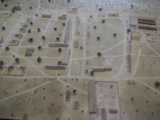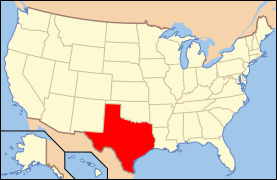Fort McKavett State Historic Site
Fort McKavett State Historic Site is located in Menard County, Texas, United States. Fort McKavett was a frontier fort established as Camp on the San Saba in 1852[2]:9 to protect settlers from Indian raids. The camp was renamed in honor of Captain Henry McKavett, who was killed in the Mexican–American War battle of Monterrey.[3]
Fort McKavett Historic District | |
Texas State Historic Site
| |
 The parade grounds of Fort McKavett State Historic Site and restored officers' quarters. | |
 Fort McKavett Historic District | |
| Location | S bank of the San Saba River, Menard County, Texas, USA |
|---|---|
| Coordinates | 30°49′37″N 100°06′29″W |
| Area | 140 acres (57 ha) |
| Built | 1846 |
| NRHP reference No. | 71000955[1] |
| RTHL No. | 4642 |
| Significant dates | |
| Added to NRHP | July 14, 1971 |
| Designated TSHS | May 17, 1968 |
| Designated RTHL | 1968 |
Other forts in the frontier fort system were Forts Griffin, Concho, Belknap, Chadbourne, Stockton, Davis, Bliss, Richardson, Clark, McIntosh, Inge, and Phantom Hill in Texas, and Sill in Oklahoma.[4] Subposts or intermediate stations were also used, including Bothwick's Station on Salt Creek between Fort Richardson and Fort Belknap, Camp Wichita near Buffalo Springs between Fort Richardson and Red River Station, and Mountain Pass between Fort Concho and Fort Griffin.[5]
Historic designations
On July 4, 1971, Fort McKavett was added to the National Register of Historic Places, number 71000955.[6]
The fort received three Recorded Texas Historic Landmarks: In 1936, marker number 4795 for the site of Fort McKavett;[7] in 1963, marker number 1998 for Fort McKavett C.S.A.;[8] and in 1968, marker number 4642 for the Sentry Building.[9]
History
Colonel Thomas Staniford's 8th Infantry established the post along the San Saba in March 1852, building the first structures, on 2300 acres leased for $600 per year.[2]:10, 16 Thomas was soon relieved by Major Pitcairn Morrison, who was relieved by Col. Edmund B. Alexander in May 1853.[2]:16 The 8th Infantry was replaced by Colonel Charles A. May's 2nd Dragoons in early 1854.[2]:16–17 The dragoons were replaced by Col. Henry Bainbridge's 1st Infantry on 15 August 1855, which remained until the fort was abandoned on 22 March 1859 under orders from General David E. Twiggs.[2]:17, 21 Companies C and F were transferred to Camp Cooper.[2]:21 Fort McKavett was abandoned in 1859 as Indian depredation in the area decreased and civilian migration to the area slowed.
With the outbreak of the American Civil War, the post was reoccupied by members of Henry McCulloch's Mounted Rifles in the fall of 1861, when the site was used by the Confederate forces as a temporary prisoner-of-war camp. The soldiers imprisoned in the fort's barracks were members of one of the six companies (B, E, F, H, I, and K) of the 8th Regiment of Infantry US that had been surrendered at the Battle of Adams Hill, north of San Antonio, on May 9, 1861. Fort McKavett remained a prisoner-of-war camp until the late spring of 1862, when the prisoners were transferred to Hempstead (near Houston) and then on to Camp Ford in Tyler, Texas. Elements of McCulloch's troops and members of the 31st Brigade of Texas State Troops then used the fort as a base of operations until the end of the war.
During the war, the fort was occupied by a few families left on the frontier despite Indians raiding at will.[2]:25 The fort was reactivated on April 1, 1868, as part of "the redeployment of a frontier military force", by Brevet L. Col. Eugene B. Beaumont's 4th Cavalry A Company, who found the conditions of the old fort "deplorable".[2]:27–28 Col. George A. Gordon assumed command on April 10, 1868, just before the arrival of Company F and Companies D, E, and I of the 38th Infantry.[2]:28
Camp followers formed a town a mile north of the post. It was supposed to be named after a German merchant by the surname of Lehne, but went by the unfortunate name of "Scabtown". The historic site itself is located 23 miles west of Menard.
Colonel Ranald S. Mackenzie assumed command of the 38th Infantry, of Buffalo Soldiers, on 15 March 1869, with Lt. Col. William R. Shafter as his aide.[2]:29 On September 1, 1869, the 38th was combined with the 41st to create the 24th Infantry under Mackenzie.[2]:29 Sergeant Emanuel Stance received the Medal of Honor after leading 10 troopers of the 9th Cavalry against Indians at Kickapoo Springs on May 20, 1870.[2]:35 Mackenzie assumed command of Fort Concho on 15 February 1871.[2]:32
As in other places in the Reconstruction Era South, the fort and nearby Scabtown experienced racial tensions and violence, notably the notorious murders of three black soldiers by prosperous local rancher John M. "Humpy" Jackson and accomplices, none of whom were ever convicted by civilian authorities.[10] The writer Robert E. Howard, a Texas history enthusiast, visited Fort McKavett some 60 years later and found local inhabitants still recalling these events—though in a biased and exaggerated version: "The arrogance of the Negro soldiers led to a fierce and bloody war between the fort and the inhabitants of the country, in which the [white] natives had the best of it. (...) Federal soldiers found their most dangerous enemies not to be Commanches" (emphasis in the original).[11]
The fort was connected by telegraph to Fort Concho, Fredericksburg, and San Antonio in 1875.[2]:37
The trail of Captain Nicholas M. Nolan's deserters associated with his Llano Estacado disastrous reconnaissance mission took place at the fort on September 27, 1877.[2]:38
The 16th Infantry, under Col. Galusha Pennypacker, arrived in March 1881, and the regiment closed the fort for good on June 30, 1883[2]:51, 54—but with the Indian threat gone, residents stayed—unlike the previous closing.[12]
By the mid-1890s, the community had 80 citizens, a weekly paper, and two hotels. In 1904, the school had 28 students and two teachers.
By the 1920s, Fort McKavett's population was about 150; it fell to 136 during the years of the Great Depression and stayed at that level until the 1960s. From a reported 103 in the '70s, it declined to a mere 45 by 1990.
Restoration
Restoration of the fort began in 1968, when the old school and one of the barracks were acquired and were under the control of the Texas Parks and Wildlife Department. The restoration continued, and by 1990, 17 buildings had been restored. On January 1, 2008, Fort McKavett was transferred from the Texas Parks and Wildlife Department to the Texas Historical Commission. Now known as Fort McKavett State Historic Site, the area is a day-use facility of 82 acres (33 ha). The site is open daily to the public.
Gallery
 Fort McKavett Historical Marker
Fort McKavett Historical Marker Looking from Captain's Quarters towards Lieutenant's Row
Looking from Captain's Quarters towards Lieutenant's Row Ruins of the Commanding Officer's Quarters
Ruins of the Commanding Officer's Quarters Model in the site museum
Model in the site museum
See also
- Fort McKavett, Texas
- Texas Forts Trail
- Forts of Texas
- List of Texas state historic sites
- National Register of Historic Places listings in Menard County, Texas
References
- "National Register Information System". National Register of Historic Places. National Park Service. July 9, 2010.
- Sullivan, J.M., 1981, Fort McKavett, A Texas Frontier Post, Lubbock: West Texas Museum Association, ISBN 0963676512
- "Fort McKavett State Historical Park" The Handbook of Texas Online
- Carter, R.G., On the Border with Mackenzie, 1935, Washington D.C.: Enyon Printing Co., p. 48
- Carter, R.G., On the Border with Mackenzie, 1935, Washington D.C.: Enyon Printing Co., p. 49
- "Natl Register of Historic Places-Menard Co, Tx". U.S. Dept of Interior. Retrieved 25 February 2011.
- "THC-Site of Fort McKavett". Recorded Texas Historic Marker. Texas Historical Commission. Retrieved 25 February 2011.
- "THC-Fort McKavett, C.S.A." Recorded Texas Historic Marker. Texas Historical Commission. Retrieved 25 February 2011.
- "THC-Fort McKavett, Sentry Building". Recorded Texas Historic Marker. Texas Historical Commission. Retrieved 25 February 2011.
- Referenced in "The Post on the San Saba", "Texas Beyond History", published by University of Texas at Austin, College of Liberal Arts
- Robert E. Howard's 1933 letters to H.P. Lovecraft and August Derleth, published by Glenn Lord in "The Howard Collector", Ace Books, 1979, P. 174, 176.
- Parent, Laurence. Official Guide to Texas State Parks. University of Texas Press, Austin. 4th printing, 2005. p 72.
External links
External links
| Wikimedia Commons has media related to Fort McKavett. |

